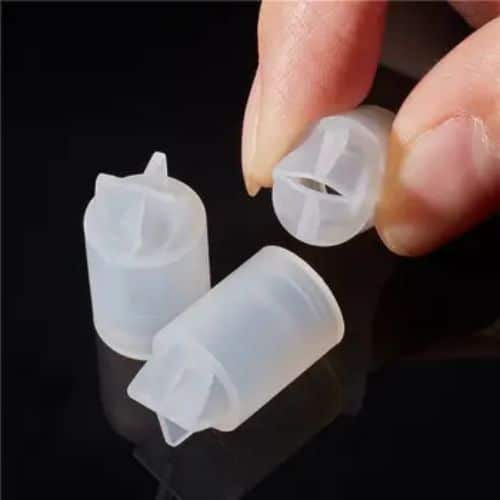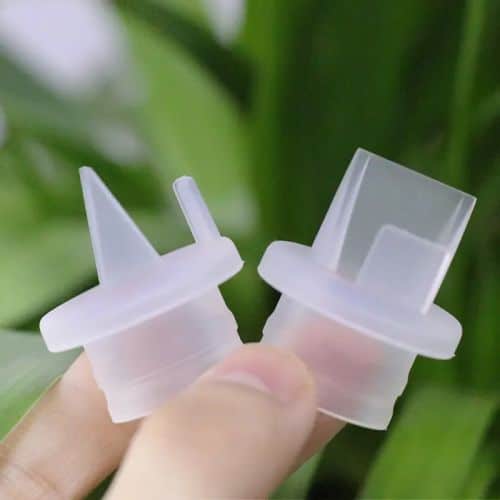Duckbill check valves made of silicone are special, adaptable parts used in a wide range of fluid control applications. These valves, so called because they resemble a duck’s bill, are essential for controlling the flow of gases and liquids. The design, functionality, advantages, and various applications of silicone duckbill check valves are all going to be discussed in this article.
What are the Characteristics of a Silicone Duckbill Check Valve?
Due to their many unique qualities, silicone duckbill check valves can be used in a variety of situations. Here are a few of the salient attributes:
• Control of Unidirectional Flow:
Duckbill check valves made of silicone are primarily known for their capacity to restrict fluid flow to one direction, thereby averting backflow as well as potential system damage.

• Durability and Resilience:
These valves are resilient and long-lasting in harsh environments because silicone has excellent resistance to temperature extremes, UV rays, ozone, and many chemicals.
• Low Maintenance:
Since silicone duckbill check valves have no moving parts that are prone to wear and tear, they require less maintenance because of their sturdy construction and straightforward design.
• Customizable:
These valves can be made to fit into a wide range of systems and be made in a variety of sizes and shapes to satisfy particular flow rate requirements.
• Silent Operation:
Duckbill check valves made of silicone have a quieter operation than some mechanical valves, which is helpful in settings where noise abatement is a priority.
• Installation Ease:
They need little in the way of special tools or configurations, making installation and replacement straightforward while saving labor costs and downtime.
• Silent Operation:
These valves can be used with a variety of fluids, including corrosive substances, because silicone material is naturally immune to corrosion.
• Low Opening Pressure:
Silicone duckbill check valves are known for their low opening pressure, enabling them to operate effectively even in low-pressure environments by allowing flow to be initiated with a small pressure differential.
Because of these characteristics, silicone duckbill check valves are a reliable and flexible option for managing liquid and gas flow in a range of industrial, medical care, and environmental applications.
What Are the Applications of Silicone Duckbill Check Valves?
Silicone duckbill check valves have been applied in many equipment and various fields. Let’s examine silicone duckbill check valve applications in more detail, including their functions and uses across a range of industries:
1. Health Care Equipment
Silicone duckbill check valves provide precise fluid and gas control in medical equipment such as infusion pumps and ventilators. They are crucial for patient safety because they stop contamination and backflow. These low-pressure, functioning valves are perfect for delicate medical applications where precise flow control is necessary.
2.Systems for Managing Water
These valves are used in water treatment plants to stop treated water from escaping back into the clean water supply. They assure that there is no reverse flow even in the event of fluctuating water pressure by functioning successfully under a range of pressure conditions. Maintaining the integrity of water treatment processes necessitates this trustworthiness.
3. Manufacturing of Medicines
In the production of pharmaceuticals, silicone duckbill check valves are used for controlling the flow of chemicals and other materials. By guaranteeing that they do not react with the processed materials, their chemical resistance helps to maintain pharmaceutical product purity and prevent cross-contamination.
4. Reaction with Chemicals
Duckbill check valves made of silicone are used in chemical processing facilities to control corrosive gases and fluids. By ceasing the reverse flow of hazardous materials, they ensure safe and effective operations by overcoming strong chemicals and extreme temperatures.
5. Automobile Systems
These valves, which serve a purpose in car coolant and fuel systems, maintain pressure and stop backflow, supporting the secure and efficient running of automotive engines. They are designed to withstand temperature changes and chemical exposure and operate well in the harsh surroundings of automotive systems.
6. Uses in the Sea
Duckbill check valves made of silicone are crucial components of the bilge pump systems on marine vessels. In addition to helping with efficient water removal and ensuring the safety of the boat and its occupants, they keep saltwater from reentering the vessel.
7. Watering Systems
These valves are used in irrigation systems in agriculture to effectively control water flow. By ensuring that water is delivered where it is needed and avoiding the contamination of clean water sources, they maximize water use and promote sustainable farming practices.

8. Goods for Consumers
Duckbill check valves composed of silicone are used in common products like sippy cups and non-drip bottles to avoid spills and leaks. Because they only permit liquid flow when necessary, they provide a user-friendly solution that is suited to consumer use.
9. Preservation of the Environment
These valves regulate water flow in flood prevention and control systems during high-water events. They are crucial for efforts to safeguard the environment in that they guarantee that water flows in a single direction, away from areas that are protected from flooding.
Silicone duckbill check valves are versatile and significant in a variety of sectors because they offer dependable, efficient, and safe solutions for controlling fluid and gas flow in each of these applications.
How to Manufacture Silicone Duckbill Check Valves?
The process of making silicone duckbill check valves is intricate and demands accuracy at every stage. Here’s a closer look at each phase of the manufacturing process and the important factors to take into account:
Step 1: Drafting and Modeling
Design Requirements: The dimensions, flow rates, and pressure requirements of the valve are included in the detailed specifications. The valve’s design must be thoroughly investigated to be sure it satisfies the unique operational specifications, such as opening pressure and backflow prevention capabilities.
Step 2: CAD, or computer-aided design
Engineers have to make sure that the design is optimized for manufacturability and performance during the CAD process while considering factors like material strength and ease of mold release.
Step 3: Prototyping
To validate the design, prototypes are tested in environments similar to those found in real-world applications. To find potential issues before mass production, this step is essential.
Step 4: Selection of Materials
Quality of Silicone: Selecting the appropriate silicone grade is essential. It requires it to be compatible with whatever fluid it comes into contact with, be it chemicals, potable water, or applications intended for medical use. Crucial variables to take into account are the material’s elasticity and resistance to environmental factors.
Material testing: To make sure the valve will function consistently for the duration of its anticipated lifespan, it is crucial to test the silicone for tensile strength, elongation, tear resistance, and compression set.
Step 5: Mold Production
Mold Design: The geometry of the valve, in particular the duckbill slit, must be precisely captured by the mold design for the valve to function. To guarantee dimensional accuracy, silicone shrinkage during cooling must also be taken into account during mold design.
Fabrication of Molds: For producing high-quality valves, mold fabrication precision is essential The quality of the valve’s surface and the ease of demolding may both be affected by the mold surface finish.
Step 6: Injection Molding
The Molding Process controls the temperature, pressure, and injection speed during this process is crucial to avoiding defects like incomplete filling, material degradation, and air entrapment.
Compression Molding: In compression molding, a consistent and flawless result is achieved by scattering the silicone material in the mold equally and using the appropriate pressure and heat.
Step 7: Remedial and Post-Production
Curing: To obtain the required material properties, the curing process demands that it be carefully regulated. To guarantee thorough curing without over-curing, which could cause the material to turn brittle, the time and temperature must be carefully controlled.
Trimming and Finishing: Take great care when trimming the valve to avoid damage, particularly in the vicinity of the significant slit area. Surface conditioning is one example of a post-processing treatment that can enhance the longevity and performance of the valve.
Step 8: Contents and Delivery
Final Inspection: This check makes sure the product satisfies all requirements and quality standards before packaging.
Packaging: To ensure that the valves show up at the end user in ideal condition, the packaging needs to protect the valves during storage and transit.
To guarantee the creation of trustworthy superior valves that fulfill the requirements of the application, extreme care to detail is needed at every stage of the silicone duckbill check valve manufacturing process.
How to Choose A Suitable Silicone Duckbill Check Valve for Equipment?
Selecting the right silicone duckbill check valve for a specific piece of machinery requires taking an array of factors into account to ensure longevity, performance, and compatibility. This is a comprehensive guide to help you choose the best silicone duckbill check valve:
Ascertain the Fluid Properties
Kind of Fluid: Determine the fluid that the valve will regulate, such as water, chemicals, oil, etc. This defines the silicone material’s essential chemical compatibility.
Warmth and Viscosity: Take into account the viscosity and operating temperature range of the fluid. For the valve to work correctly, these must be accommodated in terms of material and design. You have to pick a valve for a medical IV drip that works with both saline and prescription solutions. Medical-grade silicone should be utilized to prevent issues with the fluids.
Flow Conditions
Flow Rate: Recognize the necessary flow rate via the valve. This will assist in choosing the valve’s size and design so that it can effectively handle the anticipated flow volume.
Determine the operating pressure’s minimum and maximum using the pressure range. Both at the lowest pressure and at the highest pressure, the valve must open without breaking or deforming.
You might need a valve that can handle thousands of gallons per minute for a municipal water treatment plant. In this situation, a sizable duckbill valve able to endure high pressures and flow rates would be needed.
Fit and Size of Valve
Size and Type of Connection: To ensure a good fit, make sure the valve size and connection type (threaded, flanged, barbed, etc.) match the requirements of the apparatus.
Installation Space: Take into account the area in which the valve will be set up. Select a duckbill valve that fits inside the allotted installation area because it comes in a variety of lengths and profiles.
Compatibility of Supplies
Grade of Silicone: Make sure the silicone material is appropriate for the operating environment and the fluid. For instance, certain applications could call for silicone that is suitable for food use or that can withstand specific chemicals or temperatures.
Certifications for Materials: Certain industries, such as the medical or food processing sectors, have certification requirements for silicone materials that must be met (e.g., FDA, USP Class VI).
Performance of Operations
Cracking Pressure: To guarantee that the valve opens when required, its cracking pressure—the lowest upstream pressure needed to open the valve—should be in line with the dynamics of the system’s operation.
Tolerance for Back Pressure: The valve is required to be able to withstand the anticipated back pressure without leaking or malfunctioning. In the automobile industry, a fuel line valve needs to be robust enough to withstand the pressure of the fuel pump while maintaining a low cracking pressure to permit fuel to flow in low-pressure situations.
Sturdiness and Upkeep
Life Expectancy: Take into account the expected life of the valve in the specified application, taking into account variables like environmental conditions, operation frequency, and wear and tear.
Upkeep Needs: Understand the valve’s maintenance requirements, such as cleaning, inspection, and replacement schedules, to ensure that it continues to be dependable and functional for the duration of its life.
For instance, the valve in an outdoor agricultural irrigation system needs to be able to tolerate changes in the weather as well as possible fertilizer exposure. It would be beneficial to have a valve that is extremely resistant to UV and other substances and is simple to clean and replace.
Adherence to Industry Guidelines
Verify that the valve complies with all applicable industry standards and laws, such as the NSF for water treatment, the ISO for quality management, or particular standards for the automotive or aerospace industries. For drinking water systems, for instance, the valve’s water safety demands must be met by NSF/ANSI Standard 61. It would be essential to choose a valve that complies with this standard to be able to ensure safety and compliance.
Support and Reputation of Manufacturers
Supplier Trustworthiness: Select a valve from a reputable supplier with a solid track record of dependability and quality.
Technical Support: Verify that the manufacturer provides adequate technical support, such as help deciding on a valve, advice during installation, and post-purchase servicing.
You can choose a silicone duckbill check valve that best suits the demands of your apparatus and ensures dependability, safety, and top performance by carefully weighing all of these factors.
Because silicone duckbill check valves provide unrivaled flexibility, durability, and dependability in managing fluid flow, they are crucial parts of a variety of industries. We have examined the essential features of these valves, including their design and production methods as well as the factors to be taken into account when picking the best valve for a given application. We have also included real-world examples to highlight the practicality and adaptability of these valves. As a seasoned manufacturer of silicone with a focus on duckbill check valves, we take great satisfaction in our knowledge and capacity to offer tailored solutions that satisfy a range of operational demands. We are positioned as a trustworthy partner in your operational success because of our dedication to quality and ability to create custom silicone duckbill check valves. We make sure you have the right valve to meet your particular requirements.
